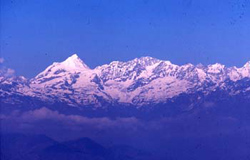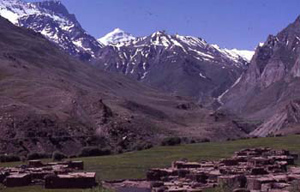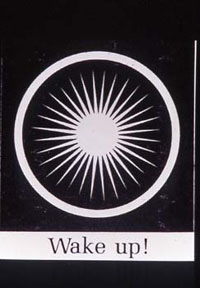
Red Cloud High School
Nature and Spirituality in the Himalayas: A Comparative Approach
| Home |
| Himalayan And Lakota Culture |
| Nature Literature |
| Comparative Mythology |
| Links |
| Bibliography |
| Biography |
Nature Literature
A growing field of study is nature literature, i.e. literature that depicts and contemplates the natural world. This genre of literature has certainly exploded as the awareness of ecology has grown in recent decades. However, this genre has roots that dig deep, from ancient creation myths to Romantic Poetry to the haiku. Modern nature writers who have come to embody this genre include Aldo Leopold, Rachel Carson, Gary Snyder, Barry Lopez, Peter Matthiessen, and Annie Dillard. Forefathers would include Henry David Thoreau and Ralph Waldo Emerson. These writers have merged the spiritual with the scientific, the rhapsodic with the concrete.
In the spring of 2007, I designed and taught a senior-level English elective called Nature & Literature. Here is the syllabus:
Nature and Literature
Mike Sunderland
Course Description:
In this class we will examine how the natural world has been portrayed in literature. Our class will look at works spanning from the earliest creation myths to the most recent modern works of “eco-literature”. We will take a cross-cultural perspective in our readings and look for common themes that reoccur across different cultures and traditions throughout time. In particular, we will focus on how writers have discovered the sacred in nature. Throughout history, people across the globe have perceived the natural world as possessing a sacred power and energy. The natural world has served as inspiration for writers in every genre: novel, poem, essay, myth, and so on. We will examine various texts on the subject as well as focus on our writing, using nature as our inspiration. The goal of this course is to not only cultivate in the student a deeper appreciation for literature and writing, but also for the natural world that is our global home.
Topics and Readings:
I. Overview/ Introduction
Readings: Edward Hoagland: Introduction to Nature Classics
Gary Snyder: “The Wilderness” (from Turtle Island)
II. Mythology
Topics: Comparative Myths: Australian Aboriginal, Native American, Japanese
Readings: Tony Allan, Fergus Fleming, and Michael Kerrigan: Journeys Through Dreamtime: Oceanian Myth
David Kinsley: “Australian Aboriginal Religion” in Ecology and Religion: Ecological Spirituality in Cross-Cultural Perspective
Richard Erdoes and Alfonso Ortiz: American Indian Myths and Legends
Juliet Piggott: Japanese Mythology
III. Classical Era
Readings: Homer: The Odyssey, Book V
Theocritus: Idyll I (Greek Pastoral Poetry)
Homeric Hymn to Pan
Ovid: The Metamorphosis, Book I
IV. Romantic Era
Readings: Robert Bly: News of the Universe: Poems of Twofold Consciousness, pgs. 1-77
William Wordsworth: “Tintern Abbey”, “I Wandered Lonely as a Cloud”, “Lines Written in Early Spring”, “Thoughts on the Seasons”, “Ode on Intimations of Immortality”
William Blake: “Introduction”, “The Shepherd”, “The Echoing Green”, “To Spring”
W.B. Yeats: “The Song of the Happy Shepherd”, “The Stolen Child”, “To the Rose upon the Rood of Time”, “The Lake Isle of Innisfree”, “The Song of Wandering Aengus’
V. Transcendentalists
Readings: Henry David Thoreau: Walden, “Walking”
Ralph Waldo Emerson: “Nature”
VI. Native American
Readings: John Neihardt: Black Elk Speaks
Vine Deloria: God is Red
Winona LaDuke: All My Relations
VII. Eastern Lit.
Readings: Lao-tzu: Tao Te Ching
Basho, Ryokan, Issa: Various Haiku
Hermann Hesse: Siddhartha
VIII. Modern Views
Readings: Gary Snyder: Turtle Island
Peter Matthiessen: The Snow Leopard
Anne Dillard: Pilgrim at Tinker Creek
Needless to say, we didn't cover all these readings in a semester, but it was a successful class. Hopefully, the syllabus will give a nice perspective on what nature literature could cover. It is a wide field that spans cultures and times. Here is a link to an essay by Barry Lopez (author of Arctic Dreams) that explores nature literature, what he calls "a literature of place": http://arts.envirolink.org/literary_arts/BarryLopez_LitofPlace.html
Here is a terrific website on nature mysticism: http://www.gardendigest.com/myst1.htm
On the rest of this page, I want to briefly explore some examples of nature literature that can be used in the high school classroom, beginning with Himalayan/Buddhist-inspired literature.
 Himalaya/ Buddhist-Inspired Literature
Himalaya/ Buddhist-Inspired Literature
Lost Horizon by James Hilton
Lost Horizon, originally published in 1933, romantically depicts Tibet as Shangri-la, a mysterious and magical place of wonder. This novel certainly helped to produce the idealistic image of Tibet as a peaceful paradise. It is entertaining to read and would be a good text to read as an example of idealization. This can be connected to the place where I teach, the Pine Ridge Indian Reservation. Many people have idealized views of Native Americans, which are not in touch with modern reality.
"When British author James Hilton portrayed four Western travelers stranded in the paradise-like valley of "Shangri-La" (which was apparently nothing but a distortion of Shambhala) in his novel "The Lost Horizon," his story became a bestseller and was twice made into a movie. From then on, the made-up world Shangri-la became a symbol of Far Eastern mysticism and meditative peace." ~ Jurgen Kremb, http://www.spiegel.de/international/spiegel/0,1518,413526,00.html
Siddhartha by Hermann Hesse
Siddhartha depicts the spiritual journey of the title character and his experiences of asceticism, pleasure-seeking, meditation, and enlightenment. This novel gives a solid perspective on Buddhism and Eastern Religions for those students who may not have encountered these traditions before.
The Snow Leopard by Peter Matthiessen
The Snow Leopard takes place in the Himalayas. This work depicts the author and his biologist companion's journey into the Himalayas in search of the elusive snow leopard. Not only is it a stunning description of the physical geography of the Himalayas, it also is a fascinating contemplation of Buddhist spirituality. It is a journey into nature and into the spirit. Matthiessen also makes connections between Tibetans and Native Americans, in regards to spirituality and culture. This is an enjoyable and challenging read and would be appropriate for advanced students.
Haiku
The Japanese haiku is a concise yet profound insight into nature and spirituality. The haiku can be described as a snapshot of reality, a window into the natural world. The haiku is inspired by Buddhism, especially the spirit of Zen. This genre is popular among students for its clarity and unpredictability.
"The love of nature is religion, and that religion is poetry; these three things are one thing. This is the unspoken creed of haiku poets." ~ R. H. Blyth
"A haiku is not a poem, it is not literature; it is a hand becoming, a door half-opened, a mirror wiped clean. It is a way of returning to nature, to our moon nature, our cherry blossom nature, our falling leaf nature, in short, to our Buddha nature. It is a way in which the cold winter rain, the swallows of evening, even the very day in its hotness, and the length of the night, become truly alive, share in our humanity, speak their own silent and expressive language." ~ R.H. Blyth
A fine website on haiku, featuring Basho, Buson, and Issa: http://www.geocities.com/alanchng1978/index.html
More haiku:
http://www.toyomasu.com/haiku/
http://www.youtube.com/watch?v=UiZTrPVh81A
Modern Himalayan Literature
The 2008 NEH Institute has opened us to the world of modern Himalayan Literature. Lauran Hartley gave an informative lecture of modern Tibetan literature, which has grown immensely since the 1980s. Hartley is the co-editor of the first systematic text on modern Tibetan Literature, Modern Tibetan Literature and Social Change. An interesting modern Tibetan book that she described and may be of interest to high school students is The Mandala of Sherlock Holmes, which describes Sherlock Holmes' missing years which he spent in none other than Tibet. Another interesting works of Himalayan literature on the 2008 NEH syllabus is The Struggle for Modern Tibet: The Autobiography of Tashi Tsering and The Tutor of History by Manjushree Thapa, a writer from Nepal.
 Romantic Poetry
Romantic Poetry
Romanticism describes a movement in art and poetry in the 1800s. The Romantics reacted against the scientific, mechanistic views of Enlightenment thinkers, such as Descartes. The Romantics wanted to revive an ancient communion and harmony with the natural word. In their work, Romantics emphasized nature, art, the emotions, spontaneity, and the imagination. In their recognition of the spiritual aspects of nature, Romantic poets have deeply inspired later writers. Important Romantic poets include William Wordsworth, William Blake, and W.B. Yeats.
"The British Romantic writers formulated an innovative and in many respects original way of understanding the natural world. Such an understanding may authentically be termed 'ecological', since for the first time in the Western intellectual tradition their poetry evinces the essential elements of a modern ecological worldview. Especially in such poets as Wordsworth, Coleridge, and John Clare, the Romantic era found itself on the threshold of an ecological perception, a sensibility that understands all of nature to be constituted as an assemblage of biotic communities characterized by diversity, complexity, and symbiosis." ~ James C. McKusick, "Ecology" in Romanticism: An Oxford Guide, edited by Nicholas Roe, pg. 209
from "Lines Composed a Few Miles Above Tintern Abbey" by William Wordsworth
And I have felt
a presence that disturbs me with the joy
Of elevated thoughts; a sense sublime
Of something far more deeply interfused,
Whose dwelling is the light of setting suns,
And the round ocean and the living air,
And the blue sky, and in the mind of man:
A motion and a spirit, that impels
All thinking things, all objects of all thought,
And rolls through all things. Therefore am I still
A lover of the meadows and the woods,
And mountains; and of all that we behold
From this green earth . . .
"The Song of Wandering Aengus" by W.B. Yeats
- I went out to the hazel wood,
- Because a fire was in my head,
- And cut and peeled a hazel wand,
- And hooked a berry to a thread;
- And when white moths were on the wing,
- And moth-like stars were flickering out,
- I dropped the berry in a stream
- And caught a little silver trout.
- When I had laid it on the floor
- I went to blow the fire a-flame,
- But something rustled on the floor,
- And some one called me by my name:
- It had become a glimmering girl
- With apple blossom in her hair
- Who called me by my name and ran
- And faded through the brightening air.
- Though I am old with wandering
- Through hollow lands and hilly lands,
- I will find out where she has gone,
- And kiss her lips and take her hands;
- And walk among long dappled grass,
- And pluck till time and times are done
- The silver apples of the moon,
- The golden apples of the sun.
A collection of ecological poems that includes an examination of the reaction against the Enlightenment by the Romantics is Robert Bly's News of the Universe: Poems of Twofold Consciousness
 Transcendentalism
Transcendentalism
Transcendentalism was a literary, philosophical, and artistic movement that arose in mid-19th century New England. Transcendentalists were influenced by the Romantics in their love of nature and imagination. Transcendentalists emphasized harmony with nature, individualism, and intuition. Transcendentalists were also influenced by philosophies of the East, namely Hinduism and Buddhism. Major Transcendentalists are Henry David Thoreau and Ralph Waldo Emerson.
"To be awake is to be alive." ~ Henry David Thoreau, Walden (Compare this to the message of the Buddha)
Here is the Ecology Hall of Fame, which includes Thoreau: http://www.ecotopia.org/ehof/index.html
A site that examines the Buddhist aspects of Thoreau by Rick Fields: http://www.ralphmag.org/thoreau-swansJ.html
Thoreau and Eastern traditions: http://www.gosai.com/chaitanya/saranagati/html/nmj_articles/east_west/east_west_2.html
http://www.vedanta.org/reading/monthly/articles/2001/9.vivekananda_and_thoreau.html
http://www.vcu.edu/engweb/transcendentalism/roots/hdt-tao.html
Thoreau and the American Indian: http://www.walden.org/institute/thoreau/about2/K/Keith_Brianne/Amer_Indian.htm
 Black Elk Speaks
Black Elk Speaks
Black Elk Speaks was written by John G. Neihardt and originally published in 1932. Black Elk, the famed Lakota spiritual leader, told Neihardt his life story so that people would remember the traditional Lakota way of life. Black Elk's life story includes his famous vision as a youth, tragic battles, a touring of England with a Wild West Show, and encounters with other famed Lakota warriors such as Crazy Horse and Sitting Bull. Black Elk Speaks beautifully and poetically captures the traditional Lakota life, as it depicts spiritual and cultural ceremonies as well as the braveries of battle. It depicts the Lakota relationship with the natural world and includes their spiritual beliefs.
A few perspectives on Black Elk Speaks:
http://nieveroja.colostate.edu/issue4/black.htm
http://faculty.smu.edu/twalker/blckelk4.htm
http://www.youtube.com/watch?v=2INJ7bNJNIc
 Gary Snyder
Gary Snyder
photo courtesy of http://www.english.uiuc.edu/maps/poets/s_z/snyder/snyder.htm
Gary Snyder is a modern writer whose work explores nature and society through a perspective that is simultaneously influenced by Buddhism, Native Americans, and ecology. His poetry(including the Pulitzer Prize winning Turtle Island)and his essays reveal his unique perspective on the world. Snyder's work offers a balance and synthesis between the concrete, physical world with the spiritual and sublime. In 1996, he published Mountains and Rivers without End, an epic poem 40 years in the making that reveals his influences of Zen, Tibetan Buddhism, and Native American myth.
Here is an excellent article on Gary Snyder from the Shambala Sun: http://www.shambhalasun.com/index.php?option=com_content&task=view&id=2071
More websites on Gary Snyder:
http://home.clara.net/heureka/art/snyder.htm
http://www.english.uiuc.edu/maps/poets/s_z/snyder/snyder.htm
http://wwwenglish.ucdavis.edu/Spark/v1n1/mttam/mttam.htm
Gary Snyder on Ecology and Poetry (Videos)
http://www.youtube.com/watch?v=D8SXDe9hnfI
http://www.youtube.com/watch?v=RzytU77e8mw&feature=related
http://www.youtube.com/watch?v=jPaPYNsjmN4&feature=related
http://www.youtube.com/watch?v=u6aK_FqYuaw&feature=related
Classroom Use:
In reading any of these texts, a good question to explore is to identify the two aspects of nature literature: (1) physical, concrete descriptions of nature and (2) spiritual contemplations or philosophical reflections. Examine one of these texts and explore these aspects. Also, think about the following questions: How is spirituality found in nature? What are the influences of Buddhist or N. American spiritualities on literature? What can literature do for the natural world? How has nature been portrayed in literature throughout history? (Nature as idyllic paradise, nature as destructive force etc.)
Move on to Comparative Mythology

